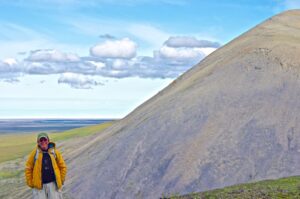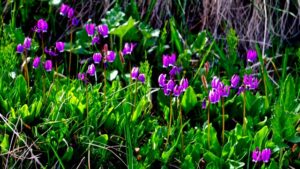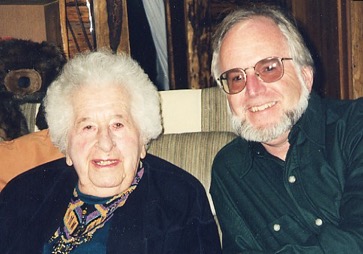
Arctic Refuge Visit Inspired by Original Advocates
Vance Carruth was one of the participants in the Trustees for Alaska’s 2015 trip to the Arctic National Wildlife Refuge. This is his story:
Last June, I spent an unforgettable four days and nights camped in the Arctic National Wildlife Refuge near where the mountains meet the Coastal Plain on a gravel bar in the Aichilik River. It was, for me, an adventure of a lifetime that had its beginning nearly a half a century earlier when I first met Margaret E. Murie in her log home nestled beneath the Grand Tetons in Wyoming. I was 19; she was 62.
I was one of a fortunate few to visit the Arctic National Wildlife Refuge thanks to Trustees for Alaska. Our fearless and experienced guide, Bob Childers, Trustees for Alaska Board of Directors member, and chief camp cook, Vicki Clark, Trustees for Alaska’s Executive Director, organized and coordinated this adventure. Also along were Trustees Board Member Jim Spitzer, his daughter Jessica, and two Alaska couples.
We camped within walking distance of the biologically rich Coastal Plain that has been the subject of a multiple decades fight to either preserve or open to drilling this last great intact wilderness between the Brooks Range of Alaska and the Arctic Ocean.
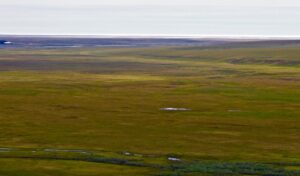
The Coastal Plain extends from the foothills of the Brooks Range to the Arctic Ocean. Photo courtesy of Vance Carruth.
“Mardy” Murie and her husband Olaus were two of the early advocates for establishing the Arctic National Wildlife Range that eventually evolved into the Arctic National Wildlife Refuge. Mardy was the first woman graduate of the University of Alaska and had grown up in Fairbanks, married Dr. Olaus J. Murie and spent her honeymoon on a dogsled caribou study into far northern Alaska in mid-winter of 1925. Theirs had been a love story that is captured in her classic book, Two in the Far North.
Mardy was probably the one individual in my life who had the most profound influence over the direction my life would take right up to this present moment. I relied on her for her wise counsel and her always dependable ability to cheer me on through the toughest of times and the happiest of times. After Olaus, who died in October of 1963, and Mardy, who passed in 2003, I found myself without the guidance of a key mentor of mine who had always been there over the 40-year friendship we had built. But, she was gone.
I had a deeply felt need to honor her memory in some small way.
She and Olaus had spent much of their lifetime fighting to secure this far northern corner of Alaska as one large intact wilderness to remain untrammeled for future generations. In 2005, when Republicans in Congress decided to attempt to get the votes needed to open up the Coastal Plain to drilling, I called upon our Jackson Hole community, which Mardy and Olaus called home for over 50 years, to join in the effort to make our voices heard to defend their legacy.
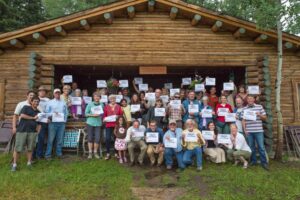
A gathering of Arctic Refuge supporters at the Murie Center. Photo courtesy of Tom Mangelsen via Vance Carruth.
Our Wyoming Congressional Delegation in Washington, D.C. were supporting their Republican colleagues in their effort to open the Arctic Refuge to drilling. We, as citizens of Wyoming, owed it to Olaus and Mardy to oppose their efforts. I knew both Olaus and Mardy would have been steadfastly opposed, with every fiber of their being, to opening this vital stretch of coastal plain to any kind of technological invasion.
Several hundred members of our community came together on a clear, warm, late October Sunday afternoon to listen to the voices of Terry Tempest Williams and many other well-known leaders, both Democratic and Republican, who spoke eloquently of their belief in the vision and foresight of the Muries in wanting to preserve the coastal plain as wilderness. This entire event was videotaped to be sent as a DVD message to our Wyoming Congressional Delegation in Washington, D.C. The lines had been drawn and ours and others’ voices from across the nation were engaged in the debate. The bill was defeated and the Coastal Plain was saved, at least for the immediate future.
It was during this frantic time frame that I had become immersed in the history of the Arctic Refuge. I watched all the videos, viewed images of this wild and beautiful landscape, and was reminded so often of the things Mardy had spoken of and the deep affection she had for Alaska and her passionate appeals to keep it wild. I had visited Alaska many times as a professional tour director. I had sailed Alaska’s Inside Passage, toured Denali National Park, and visited Fairbanks. But I never had the opportunity to see and experience the Arctic Refuge lands the Muries so loved. I was not in a position, financially, to afford such an adventure, yet still I felt if it was meant to be, someday I might just get there. This was my dream!
It was one of my dearest friends, a former middle school student of mine who has been a donor to Trustees, who was called regarding her husband and her joining this trip to the Arctic Refuge. They were unable to do so, but my friend told Vicki about me and all the work I had done earlier to keep the Arctic Refuge safe from development and how much she understood I wanted to get there someday.
At age 70, I wasn’t certain I would be up to the challenges of trekking through the tundra, but I truly wanted to have this once in a lifetime opportunity to experience the Arctic Refuge for myself. I wanted to see this mysterious faraway place that had so captivated the Muries and had driven them to battle to preserve it for future generations.
It is impossible to adequately describe how I felt upon landing on a gravel bar in the heart of the Arctic National Wildlife Refuge. Suffice it to say, I was blown away by the sheer size of the landscape surrounding me. The immense expanse of sky unstreaked by jet fuel exhaust. The crisp, clean air! Only hearing the sounds of birds that would sing 24 hours a day! The sun being suspended above the horizon at its lowest point in the northeastern sky providing a soft eerie light at 2 AM. Looking south only my very long shadow stretched to the southwest towards mountains that always seemed so close, yet were so far away!
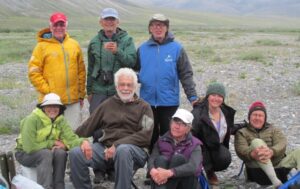
Our group. Clockwise from top left: author Vance Carruth, Bob Childers, Jim Spitzer, Jessica Spitzer, Wally Cole, Jerri Cole, John Mouw, Rika Mouw. Not pictured: Vicki Clark. Photo courtesy of Vicki Clark.
For three full days, the nine of us, camped and hiked. The first day we hiked to the north of camp, the second day to the west of camp, and the final day to the south of camp. One evening we were all spellbound for several hours watching a herd of caribou moving from the south across the broad expanse of the valley, then up and along the shoulder of the mountain that rose to the west of camp where they disappeared over the saddle of the ridge to our north. I had not expected I’d see even a portion of the spring migration of the Porcupine Caribou Herd on this brief visit. It was indeed a magical experience!
Another highlight of this short visit for me was seeing the multitude and variety of millions of tiny vivid wildflowers spread like a carpet through the tundra that stretches to infinity. We were fortunate to be there in mid-June. I understood how brief and intense this season of endless daylight really is, not just for the abundance of wildflower displays, but because by early July, millions of mosquitoes would be a constant and persistent annoyance.
On the day we hiked up the slopes of the mountain that rose to our west, I was astounded by the sweeping view I had looking north across the 20-mile stretch of the Coastal Plain toward the shimmering stretch of white that filled the northern horizon. I could see the Arctic Ocean icepack! I doubt I will ever forget the overpowering feeling of awe I experienced taking in that view.
On our trek onto the coastal plain we came upon a pair of rough-legged hawks who were nesting high up on an enormous nest they had constructed over a hundred feet above the cobble strewn river bottoms where the Aichilik River had deeply cut into the terraced western river bank that towers above the coastal plain. One hawk remained on the nest while the other wheeled overhead, screeching high above us. Might we have been the only humans they had ever seen in their lifetimes? Not likely, but a rare and wonderful moment I will never forget.
On our last hiking day, Bob Childers took us on a jaunt into the tussocks to witness an enormous V cut into the hillside created by rapidly thawing permafrost that had exposed a wedge of ice likely 8-to 10-feet thick that showed just how quickly these ice wedges are disintegrating. Even though it was relatively early spring in the Arctic, there was surprisingly little of the aufeis that normally would still be exposed along the braided river channels of the Aichilik River.
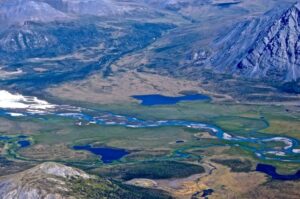
Aerial view Last Lake in the Sheenjek Valley where the Muries camped during their 1956 Arctic Expedition. Photo courtesy of Vance Carruth.
On both flights into and out of the Arctic Refuge, the pilots were kind enough to fly us right over the campsite where Olaus, Mardy, Brina Kessel, Bob Krear, and George Schaller conducted their observations during the 1956 Arctic Expedition. I silently gave thanks to them for what they accomplished. I knew how deeply moved Mardy and Olaus had both been at the end of this expedition, Olaus’ last time to experience his beloved Alaska Wilderness!
I could envision the two of them in my mind’s eye joyously dancing to John Denver’s classic song written for them. I can hear him singing these words now, “I see them dancing somewhere in Alaska… I hear them singing, a song for all lovers… A song for the two hearts beating only as one!” But for me the most important line in the song was and is, “Will the future remember when the lovers are gone?” What an incredible legacy they left for us to emulate and share with future generations!
I thank Trustees for Alaska for allowing me to fulfill my dream. And I thank them for continuing the work of protecting the wilderness character of the Arctic National Wildlife Refuge. These are the lands of the midnight sun that are so important to all of us who love wild and untrammeled places. I hope the future will remember the two lovers who dreamed of doing what others would not in order to make the Arctic Refuge possible. I happily honor their memory now and always! May permanent Wilderness status for the Coastal Plain become the legacy they helped earn for all of us!
“Beauty is a resource in and of itself. Alaska must be allowed to be Alaska, that is her greatest economy. I hope the United States of America is not so rich that she can afford to let these wildernesses pass by, or so poor she cannot afford to keep them.”
Margaret Murie at the Alaska Lands Act Hearing, September 1964
Learn more about Trustees for Alaska’s work to protect the Arctic National Wildlife Refuge.



